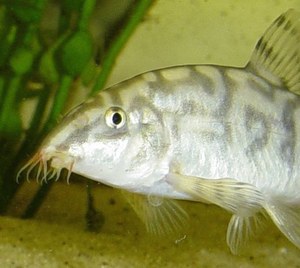Here's the 'up and up' on Yo-Yo's
"Yoyo" Loach (Botia almorhae)
Summary

Scientific Name: Botia almorhae (Gray, 1831)
Common name: Yoyo Loach, Almorha Loach, Pakistani Loach, Reticulated loach
Synonyms: Botia lohachata
Distribution: India, Nepal, Bangladesh.
Sexual Dimorphism: Females generally plumper all over than males and can get extremely fat when full of eggs. Males exhibit redness around barbels and mouth.
Maximum size: 6 inches
Similar to: Botia rostrata, Botia histrionica
Care: In nature, the fish live in calmer water pool areas of highland streams. The young are usually found in more lowland waters. The tank should include lots of hiding places amongst rocks and driftwood. Excellent diggers that appreciate a sand substrate to protect the delicate barbels. Lighting should be subdued.
Feeding: Good quality flake, sinking pellets, algae wafers, chopped earthworms, thawed frozen Bloodworm, Mysis Shrimp, chopped cocktail shrimp. Avoid over-feeding as these fish are very greedy. This species is an avid consumer of snails.
Water parameters: pH:6.5-7.5 Hardness: Medium Max dh: <12
Temperature: 76ºF to 82ºF(22-27.7°C)
Breeding: Not bred in aquaria, but mature females regularly fill with spawn.
Notes
 Botia almorhae is a generally peaceful, robust loach that is regularly available. They should be kept in a group of their own species. Like Clown Loaches, they have a social structure, and a certain amount of in-fighting will be seen. For this reason, provide numerous hiding places so that less dominant fish may escape the attentions of more boisterous individuals. During times of fighting or sometimes at feeding time, a pair of fish may "gray out." The base colour will darken considerably, changing the contrast between the markings and the regular body colour, so that the fish resembles more the colouration shown in the picture of the highly reticulated adult below.
Botia almorhae is a generally peaceful, robust loach that is regularly available. They should be kept in a group of their own species. Like Clown Loaches, they have a social structure, and a certain amount of in-fighting will be seen. For this reason, provide numerous hiding places so that less dominant fish may escape the attentions of more boisterous individuals. During times of fighting or sometimes at feeding time, a pair of fish may "gray out." The base colour will darken considerably, changing the contrast between the markings and the regular body colour, so that the fish resembles more the colouration shown in the picture of the highly reticulated adult below.
Body markings can be very variable in this species, and there is a marked difference between juveniles and adults. Adults develop more "in-fill" of the juvenile markings to a point where the whole fish may be reticulated, hence one of its common names.
Within the ornamental fish trade and in most countries in the aquatic community, the fish is now known as the Yoyo Loach. This term was coined because of the noticeable juvenile pattern consisting of alternate 'Y's and 'O's along the fish's sides, and is credited to our long-term Loaches Online member, Ken Childs while he was working at Dolphin International, a fish importers in Los Angeles.



1 comment:
Interesting. Jocelyn loves animals. Do you have a photo? I would like to see the "yo yo" too!
Post a Comment